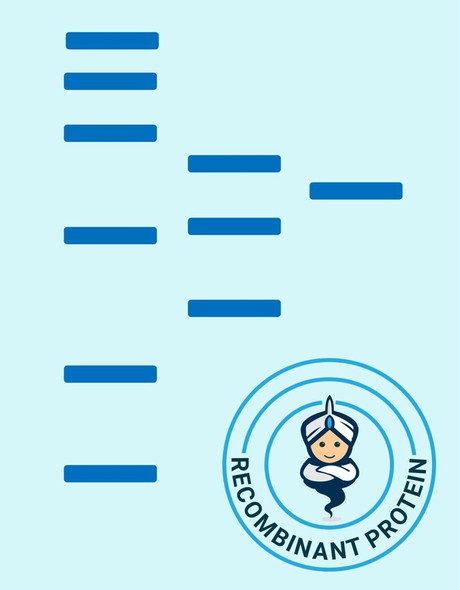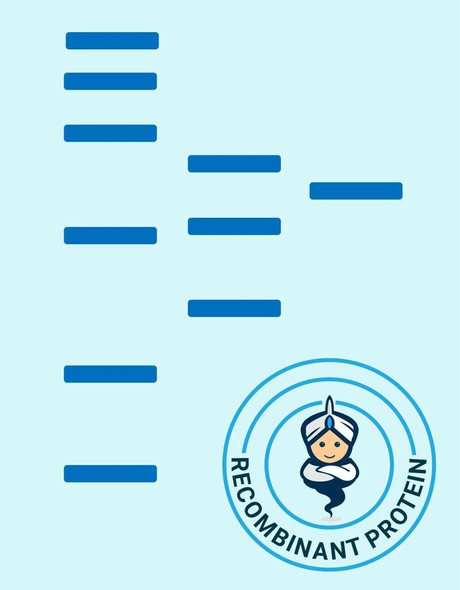Growth Factors & Cytokines Recombinant Proteins
Human Prolactin Recombinant Protein (RPPB0871)
- SKU:
- RPPB0871
- Product Type:
- Recombinant Protein
- Species:
- Human
- Uniprot:
- P01236
- Research Area:
- Growth Factors & Cytokines
Description
| Product Name: | Human Prolactin Recombinant Protein |
| Product Code: | RPPB0871 |
| Size: | 100µg |
| Species: | Human |
| Target: | Prolactin |
| Synonyms: | Mammotropin, Luteotropic hormone, Luteotropin, PRL. |
| Source: | Escherichia Coli |
| Physical Appearance: | Sterile Filtered White lyophilized (freeze-dried) powder. |
| Formulation: | The protein was lyophilized from a concentrated (1mg/ml) solution with 0.02% NaHCO3. |
| Solubility: | It is recommended to reconstitute the lyophilized Prolactin in sterile 0.4% NaHCO3 pH-8.5, not less than 100�g/ml, which can then be further diluted to other aqueous solutions. |
| Stability: | Lyophilized Prolactin although stable at room temperature for 3 weeks, should be stored desiccated below -18°C. Upon reconstitution Prolactin should be stored at 4°C between 2-7 days and for future use below -18°C.For long term storage it is recommended to add a carrier protein (0.1% HSA or BSA).Please prevent freeze-thaw cycles. |
| Purity: | Greater than 95.0% as determined by gel filtration analysis. |
| Biological Activity: | Pegylated Human Prolactin was tested for its biological functionality in-vitro by inducing proliferation of Nb2 cells or Baf/3 cells that were stably transfected with Human Prolactin receptors, though its activity is lower than human Prolactin. However, it is anticipated that its biological activity in vivo will be higher than human Prolactin due to prolonged persistence in circulation. |
Prolactin is a neuroendocrine hormone synthesized primarily by the pituitary gland but also a variety of other cell types including the placenta, brain and uterus. Prolactin is secreted when eating, nursing, mating, estrogen treatment and during ovulation. Prolactin's primary role is to promote and maintain lactation but also plays a role in breast cancer development, regulation of reproductive function and immunoregulation.
Prolactin Human Recombinant Pegylated produced in E.Coli is a single, non-glycosylated polypeptide chain containing 199 amino acids + an additional Ala at n-terminal. Pegylated Prolactin is mono-pegylated having a molecular mass of ~ 39 kDa, however under non-denaturing conditions it behaves as 220 kDa protein due to its increased hydrodynamic volume.The Pegylated Prolactin protein is purified by proprietary chromatographic techniques.
| UniProt Protein Function: | prolactin: Prolactin acts primarily on the mammary gland by promoting lactation. Belongs to the somatotropin/prolactin family. |
| UniProt Protein Details: | Protein type:Secreted, signal peptide; Secreted; Cytokine; Motility/polarity/chemotaxis Chromosomal Location of Human Ortholog: 6p22.3 Cellular Component: extracellular region Molecular Function:protein binding; prolactin receptor binding; hormone activity Biological Process: lactation; cell proliferation; cell surface receptor linked signal transduction; regulation of multicellular organism growth; positive regulation of JAK-STAT cascade; female pregnancy |
| NCBI Summary: | This gene encodes the anterior pituitary hormone prolactin. This secreted hormone is a growth regulator for many tissues, including cells of the immune system. It may also play a role in cell survival by suppressing apoptosis, and it is essential for lactation. Alternative splicing results in multiple transcript variants that encode the same protein. [provided by RefSeq, Aug 2011] |
| UniProt Code: | P01236 |
| NCBI GenInfo Identifier: | 130930 |
| NCBI Gene ID: | 5617 |
| NCBI Accession: | P01236.1 |
| UniProt Secondary Accession: | P01236,Q15199, Q92996, |
| UniProt Related Accession: | P01236 |
| Molecular Weight: | 25,876 Da |
| NCBI Full Name: | Prolactin |
| NCBI Synonym Full Names: | prolactin |
| NCBI Official Symbol: | PRL�� |
| NCBI Protein Information: | prolactin; decidual prolactin |
| UniProt Protein Name: | Prolactin |
| UniProt Gene Name: | PRL�� |
| UniProt Entry Name: | PRL_HUMAN |






